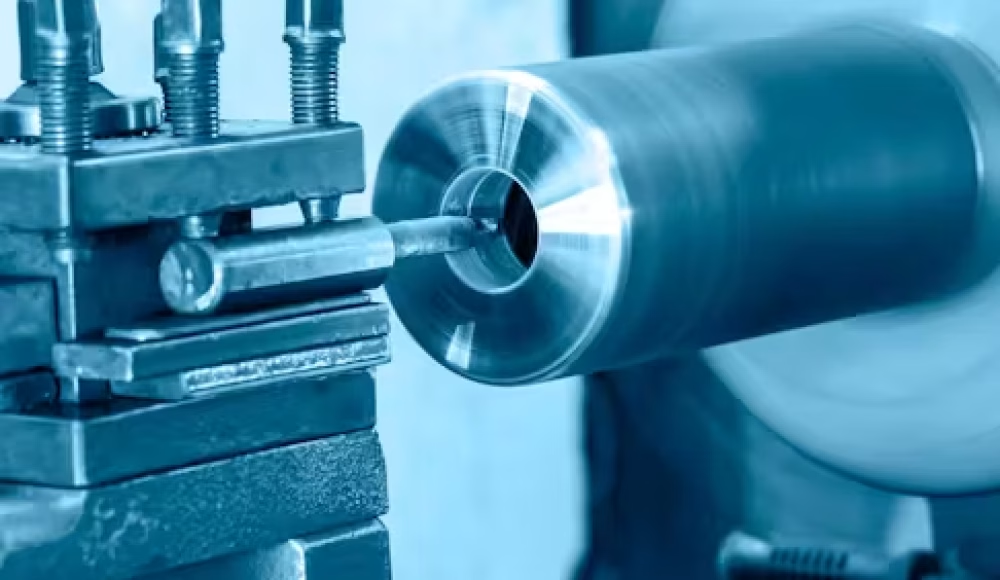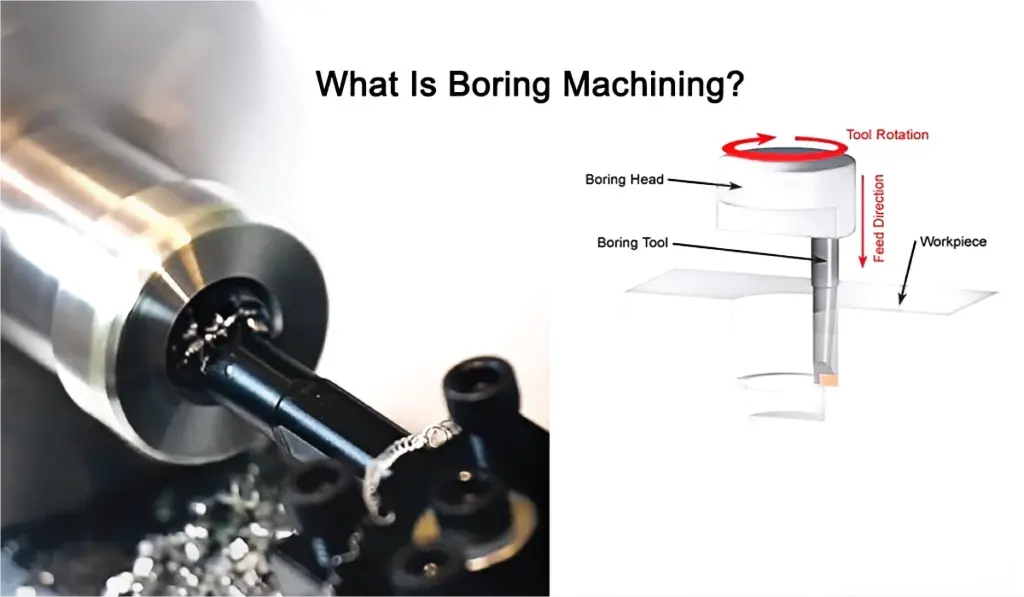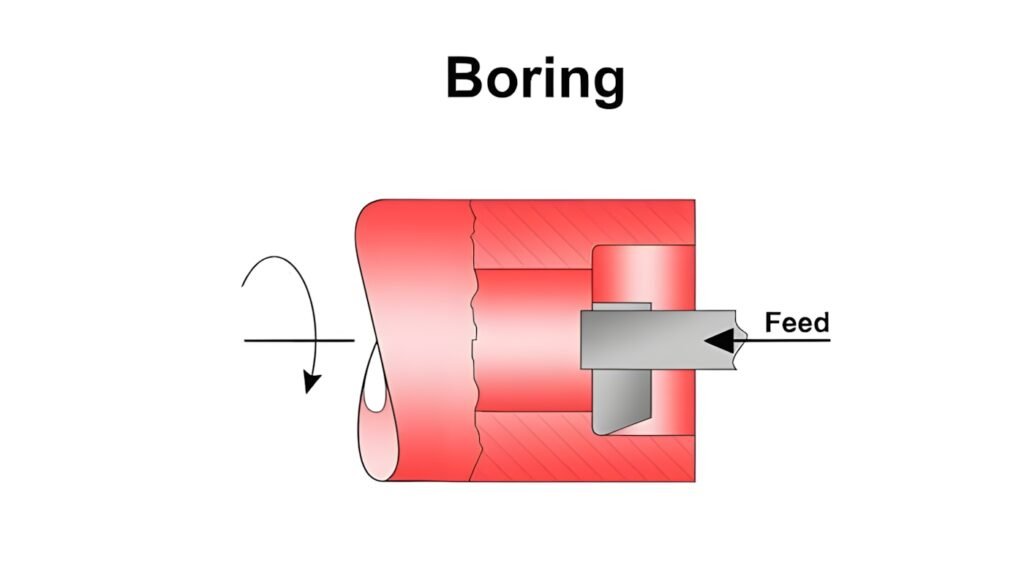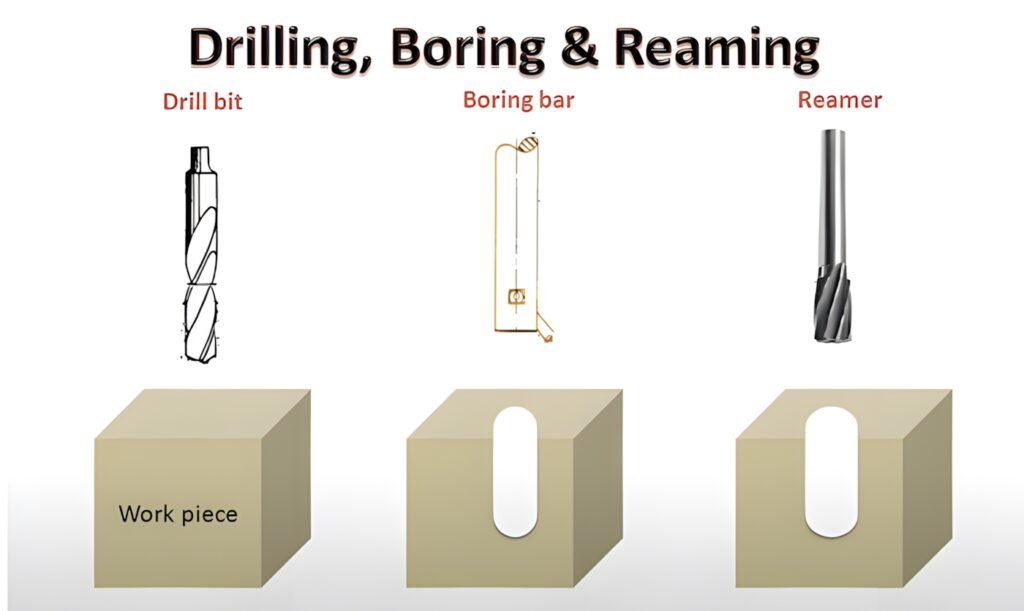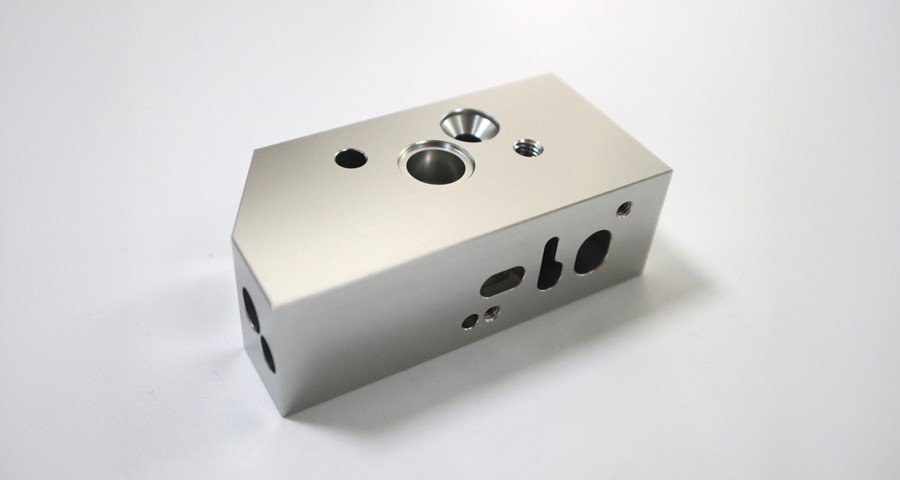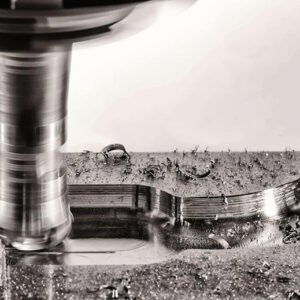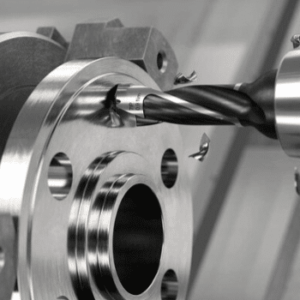Achieving precise hole sizes and exceptional surface finishes is critical—especially in industries such as aerospace, 自動車, medical device production, and heavy machinery manufacturing. One of the most effective methods to meet these demands is boring machining.
Unlike drilling, which creates a new hole from scratch, boring is the process of enlarging and refining an existing hole that was originally drilled, キャスト, or forged. This secondary machining process allows manufacturers to achieve micron-level accuracy, improve concentricity, and produce superior surface finishes.
このガイドはaを提供します comprehensive, engineer-focused deep dive into boring machining—its advantages, 制限事項, プロセス, equipment types, 課題, 成功のための専門家のヒント.
What is Boring Machining?
Boring machining is a precision machining method used to enlarge, align, または終了します an existing hole to meet exact specifications.
Key purposes include:
Increasing hole diameter to match design tolerances
Correcting misaligned or imperfectly drilled holes
Improving surface finish for better component performance
Ensuring concentricity with other features in the part
The operation is typically carried out using a single-point cutting tool called a boring bar, mounted on equipment such as a 旋盤, CNCミリングマシン, または specialized boring machine.
Advantages of Boring Machining
Exceptional Accuracy
Boring can achieve tolerances as tight as ±0.0005インチ (±0.0127 mm)—up to 40 times more precise than standard drilling.
優れた表面仕上げ
With the right tooling and cutting parameters, boring can produce finishes of 32 micro inches Ra or better, improving sealing surfaces and wear resistance.
多用途性
Works on a wide range of materials—鋼鉄, アルミニウム, チタン, 真鍮, プラスチック, 複合材—and can create features beyond circular holes, のような スロット, 溝, とキー溝.
Custom Hole Sizes
Not restricted to standard drill diameters—ideal for parts requiring non-standard or oversize holes.
Efficiency in Mass Production
CNC-controlled boring machines can process multiple parts with 一貫した再現性, reducing scrap rates and increasing throughput.
Limitations of Boring Machining
Despite its benefits, boring machining has several drawbacks:
High Equipment Cost – Precision boring machines and CNC centers require significant capital investment.
Skilled Operator Requirement – Precision setup and tool alignment are critical for accuracy.
Only Works on Existing Holes – Requires a pre-drilled or cast hole before boring begins.
Setup Time for Small Runs – May not be cost-effective for one-off jobs.
Tool Deflection Risk – Especially in deep hole boring, leading to diameter variations.
How Boring Machining Works
Make a pilot hole
Drill or cast a hole slightly undersize (so there’s material left to clean up).
Deburr/chamfer the entrance so the boring bar enters cleanly.
Set up and align
旋盤: Indicate the part so the existing hole runs true; mount the boring bar as short and rigid as possible.
Mill: Locate the hole center with a probe/edge finder; fit a boring head or boring toolholder in the spindle.
Rough bore
Take a few larger radial steps (bigger depth of cut) to remove most of the stock quickly.
離れる 0.10–0.30 mm (0.004–0.012″) per side for finishing (varies by material/size).
Semi-finish (optional but smart)
Reduce depth of cut and feed to stabilize size and improve roundness.
Re-measure; compensate for any thermal drift or tool deflection.
Finish bore
取る one or two light passes (例えば, 0.02–0.08 mm / 0.001–0.003″ per side).
Use consistent coolant/air and steady feed to hit size and surface finish.
Add a spring pass (same size, no offset) if the part/material “springs back.”
Measure and verify
aを使用します bore gauge, air gauge, または telescoping gauge + mic for size and roundness.
チェック concentricity そして position to the datum (CMM if critical).
Deburr the entrance/exit; add a small chamfer if specified.
Types of Boring Machines
Horizontal Boring Machine
それは何ですか: The spindle (the part holding the cutting tool) is mounted horizontally.
When to use it: に最適です long parts or when you need to bore holes deep into the side of a large workpiece.
Typical jobs: エンジンブロック, machine bases, large plates.
なぜそれが素晴らしいのか:
ハンドル big, heavy workpieces 簡単に.
Excellent for precision on large-scale industrial components.
Vertical Boring Machine
それは何ですか: The spindle is mounted vertically, and the workpiece usually sits flat on a rotating table.
When to use it: に最適です 大きい, 重い, and awkwardly shaped parts that are easier to handle lying flat.
Typical jobs: Turbine casings, big flanges, large valves.
なぜそれが素晴らしいのか:
Gravity helps keep the part stable.
Easier to load and unload heavy parts.
Floor Boring Machine
それは何ですか: A massive machine with a moving column and spindle, designed for very large components placed directly on the shop floor or a heavy-duty table.
When to use it: のために huge industrial parts that don’t fit on standard machine tables.
Typical jobs: Shipbuilding parts, wind turbine hubs, large gear housings.
なぜそれが素晴らしいのか:
Can machine parts so big they have to stay in one place.
Handles heavy-duty, high-precision work.
Jig Boring Machine
それは何ですか: A super-precise machine designed to produce exact hole locations そして仕上げ, often used to make jigs, 備品, and precision tooling.
When to use it: いつ tolerances are extremely tight and accuracy is the top priority.
Typical jobs: 航空宇宙部品, high-end molds, die sets.
なぜそれが素晴らしいのか:
Incredibly accurate positioning.
Perfect for work that can’t afford even a tiny alignment error.
CNC Boring Machine
それは何ですか: A computer-controlled boring machine that automates movement, スピード, and tool adjustments.
When to use it: のために 大量生産 or parts with complex boring requirements.
Typical jobs: 自動車エンジン部品, 油圧シリンダー, industrial machinery parts.
なぜそれが素晴らしいのか:
Highly repeatable results.
Can handle complicated programs and multi-step boring in one setup.
Line Boring Machine
それは何ですか: A portable or stationary machine that bores a straight, perfectly aligned hole through multiple surfaces in a single setup.
When to use it: To repair or machine bores in place without moving the part to a big machine.
Typical jobs: Repairing large equipment like excavators, boring through bearing housings, gearbox bores.
なぜそれが素晴らしいのか:
Saves time and money on heavy equipment repairs.
Ensures perfect alignment between multiple bores.
Types of Boring Processes
Line Boring
Aligns bores in components like エンジンブロック, タービン. Tool supported at both ends for rigidity.
Back Boring
Enlarges a hole from the opposite side—used in firearm manufacturing and hydraulic components.
Blind Boring
Creates a hole that does not pass completely through the workpiece—common in hydraulic manifolds.
Micro Boring
に使用されます 小さい, 正確な穴 in medical devices and aerospace parts, often requiring tolerances within ミクロン.
垂直 & Horizontal Boring
Choice depends on workpiece size, 形, and weight.
Common Challenges in Boring Machining
振動 – Caused by long boring bars; leads to chatter marks.
Tool Deflection – Affects diameter accuracy.
Maintaining Concentricity – Especially in deep holes.
Machine Wear – Can cause accuracy loss over time.
Surface Finish Control – Requires precise cutting parameters.
発熱 – Must be managed with coolants to prevent dimensional distortion.
Expert Tips for Better Boring Machining
Use the Right Tool Material & Geometry – Carbide inserts for harder metals; high-speed steel for softer materials.
切削パラメータの最適化 – Adjust スピード, 餌, そして切込み深さ for material type.
Keep Boring Bars Short & Rigid – Reduces vibration and deflection.
Perform Regular Machine Maintenance – Prevents performance drop.
Use High-Quality Coolants – Improves finish and extends tool life.
Boring vs Other Machining Processes
| プロセス | 精度 | 表面仕上げ | 目的 | 一般的な許容差 |
| つまらない | 非常に高い | 32 μin Ra | Enlarge/refine existing holes | ±0.0005インチ |
| 掘削 | 中くらい | 125 μin Ra | Create new holes | ±0.02 in |
| リーミング | 高い | 63 μin Ra | Slightly refine holes | ±0.001 in |
| フライス加工 | 変数 | 125 μin Ra | Create holes/features | ±0.01 in |
Applications of Boring Machining
自動車産業 🚗
使用されている場所: エンジンブロック, cylinder bores, crankshaft housings, and gearbox cases.
Why boring matters here: Engines need holes that are perfectly round and aligned to keep everything running smoothly and reduce wear. Even a tiny misalignment can cause vibration or damage over time.
航空宇宙産業 ✈✈️
使用されている場所: Jet engine housings, 着陸装置コンポーネント, and structural frames.
Why boring matters here: 航空宇宙分野, weight and precision are critical. Boring helps achieve 厳しい許容範囲 and smooth finishes that ensure safe, reliable performance at extreme speeds and temperatures.
Heavy Machinery and Construction Equipment 🚜
使用されている場所: Excavator arms, loader joints, ベアリングハウジング, and gearboxes.
Why boring matters here: These parts take a lot of stress, so the bores must be 強い, aligned, and able to handle heavy loads without failure.
油, ガス, and Energy Sector ⚙⚙️
使用されている場所: タービンハウジング, pump casings, and drill components.
Why boring matters here: The bores in these parts often carry high-pressure fluids or gases, so they need to be accurately machined to prevent leaks and withstand extreme conditions.
海洋産業 🚢
使用されている場所: Ship propeller shafts, エンジンマウント, and large gearbox housings.
Why boring matters here: Marine parts are exposed to harsh saltwater environments, so boring helps ensure proper fit and alignment, reducing wear and corrosion over time.
医療機器 🏥
使用されている場所: 手術器具, 整形外科用インプラント, and diagnostic devices.
Why boring matters here: In the medical world, 精度がすべてです. Holes must be スムーズ, burr-free, そして完全に形作られています to avoid complications or damage during use.
金型製作 🛠🛠️
使用されている場所: Injection mold bases, die sets, そして治具.
Why boring matters here: Perfectly bored holes ensure that molds align correctly, producing consistent, high-quality parts every time.
結論
Boring machining remains one of the most reliable and precise methods for achieving perfect hole geometry in manufacturing. While it requires specialized equipment, 熟練したオペレーター, and careful setup, the results—high accuracy, 優れた表面仕上げ, and repeatability—make it indispensable in many industries.
よくある質問
1. What is the fundamental difference in function between drilling, つまらない, そしてリーマ加工?
-
掘削: The primary process of creating a new hole from solid material, offering moderate accuracy.
-
つまらない: The process of enlarging and correcting an existing hole to achieve high precision in diameter, 丸み, 場所 (concentricity).
-
リーミング: A finishing process used to slightly refine an existing drilled or bored hole, improving its size tolerance and surface finish, but only removing a very small amount of material.
2. Why is the “boring bar overhang” such a critical factor in the success of the operation?
The boring bar overhang (the length the bar extends from the holder) directly impacts 剛性. Because the tool is only supported at one end, excessive overhang causes the boring bar to vibrate severely (おしゃべり) when cutting. Chatter leads to poor surface finish, inaccurate dimensions (hole size variation), and rapid tool wear. The general rule is to keep the bar overhang as short as possible.
3. What is a “spring pass” in finish boring, そしてなぜそれが使われるのか?
A spring pass is a final, light cut taken with zero additional offset or change in cutting depth. Its purpose is to compensate for the slight elastic deflection or “springing” of the boring bar or the workpiece during the previous cut. By running the tool through the same path again without changing the setting, it cleans up any minor material left behind due to deflection, ensuring the final hole size is precisely what was programmed.
4. How does a Line Boring Machine differ from a standard Horizontal Boring Machine?
-
Standard Horizontal Boring Machine: 機械加工に使用されます 大きい, heavy components in a controlled machine shop environment. The boring bar is supported at one end by the spindle.
-
Line Boring Machine: Designed specifically to machine a perfectly straight and aligned series of bores through multiple separate mounting points (like bearing housings on an engine block). Critically, the boring bar is typically supported at both ends of the bore series for maximum rigidity, often used for repair work in situ (on-site).
5. What is the primary cause of poor surface finish in a bored hole?
The most common cause of poor surface finish in boring is vibration or chatter, usually resulting from excessive boring bar overhang or insufficient machine rigidity. Other contributing factors include:
-
Dull Tooling: The cutting edge pushing material rather than cleanly slicing it.
-
Improper Feed Rate: Too high of a feed rate leaves deep spiral marks on the surface.
-
Insufficient Coolant: Allowing heat to build up, causing the material to deform.
6. When should Micro Boring be used, and what level of accuracy can it achieve?
Micro boring is reserved for extremely small holes (typically less than 1 んん または 0.04 インチ in diameter) or applications requiring the absolute highest precision. It uses specialized, tiny tools and is capable of achieving accuracy within ミクロン (thousandths of a millimeter), making it essential for medical devices, fuel injectors, and high-end aerospace instrumentation.
7. Why is heat generation a major concern in precision boring, even with coolant?
While coolant helps, heat is a concern because it causes 熱膨張 of both the workpiece and the boring bar. Even a tiny temperature increase can temporarily change the diameter of the part or the length of the tool, leading to dimensional errors. This requires machinists to monitor temperature closely and use a consistent flow of coolant during the finishing pass to stabilize the dimensions.
続きを読む:
CNCフライス加工: A Complete Guide to Precision Machining
CNC旋削加工: Principles and Applications

